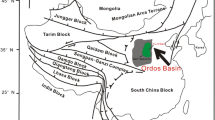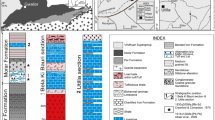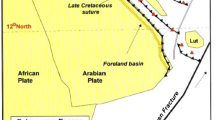Abstract
The occurrence of Precambrian stromatolites is closely related to the ancient seawater composition and the evolution of life. It is also a potential oil and gas reservoir. In what kind of environment the stromatolites of the upper Ediacaran Qigebulak Formation in the Tarim Basin developed, and whether they constitute potential hydrocarbon reservoirs, remained unclear. Stromatolites occur in 1–5 m thick layers, interbedded with thrombolites and dolostones. Distinct stromatolite morphologies were observed, including columnar, sinuous, short columnar, domal, and conical shapes. The δ13C values of the stromatolites (6.1‰ on average) are slightly lighter than those of the dolostones, and the δ18O values (− 1.4‰ on average) are significantly heavier than that of the dolostones. The stromatolites have a relatively high content of rare-earth elements and a minor Ce anomaly. The geochemical results imply that the stromatolites formed in an evaporative hypersaline lagoon environment. The presence of barrier dams near the coast led to the formation of lagoons, where hypersalinity was achieved when evaporation was greater than marine or freshwater input. High salinity conditions inhibited the growth of Ediacaran metazoans, allowing the buildup of stromatolites in the restricted lagoons. The stromatolites are rich in primary fenestral pores and sheet-like cavities along the laminae, and the secondary dissolution pores and vugs are related to meteoric karstification. The stromatolites, together with dolostones and thrombolites, constitute the majority of the hydrocarbon reservoirs in the Upper Ediacaran in the Tarim Basin. The results clarify the environment where the stromatolites could still flourish and be well preserved whereas they significantly declined globally throughout the Neoproterozoic elsewhere. The results imply that extensive stromatolites in the Proterozoic strata are potentially important reservoir rocks of Precambrian petroleum systems.


















Similar content being viewed by others
References
Allwood AC, Walter MR, Kamber BS, Marshall CP, Burch IW (2006) Stromatolite reef from the early Archaean era of Australia. Nature 441:714
Allwood AC, Walter MR, Burch IW, Kamber BS (2007) 3.43 billion-year-old stromatolite reef from the Pilbara Craton of Western Australia: ecosystem-scale insights to early life on earth. Precambrian Res 158:198–227
Andres MS, Reid RP (2006) Growth morphologies of modern marine stromatolites: a case study from Highborne Cay, Bahamas. Sediment Geol 185:319–328
Awramik SM, Sprinkle J (1999) Proterozoic stromatolites: the first marine evolutionary biota. Hist Biol 13:241–253
Awramik SM, Schopf JW, Walter MR (1983) Filamentous fossil bacteria from the Archean of Western Australia. Dev Precambrian Geol 7:249–266
Bauld J (1984) Microbial mats in marginal marine environments: Shark Bay, Western Australia, and Spencer Gulf, South Australia. In: Cohen Y, Castenholz RW, Halvorson HO (eds) Microbial mats: stromatolites. Alan Liss, New York
Bhat GM, Craig J, Hafiz M, Hakhoo N, Thurow JW, Thusu B, Cozzi A (2012) Geology and hydrocarbon potential of Neoproterozoic-Cambrian Basins in Asia: an introduction. Geol Soc Lond Spec Publ 366:1–17
Bishop JW, Osleger DA, Montañez IP, Sumner DY (2014) Meteoric diagenesis and fluid-rock interaction in the Middle Permian Capitan backreef: Yates Formation, Slaughter Canyon, New Mexico. AAPG Bull 98:1495–1519
Byrne RH, Sholkovitz ER (1996) Marine chemistry and geochemistry of the lanthanides. In: Gschneidner KAJ, Eyring L (eds) Handbook on the physics and chemistry of rare earths, vol 23. Elsevier, Amsterdam, pp 497–593
Callow RH, Brasier MD (2009) Remarkable preservation of microbial mats in Neoproterozoic siliciclastic settings: implications for Ediacaran taphonomic models. Earth Sci Rev 96:207–219
Chen LP, Zhang H, Cai ZX, Cong FY, Huang S, Tang P (2020) Characteristics and formation mechanisms of the unconformity-related paleokarst reservoirs in the Upper Sinian, Northwestern Tarim Basin, China. Mar Pet Geol 120:104559
Cheng YQ, Wang ZJ, Huang ZG (2009) General treatise of Chinese strata. Geological Press, Beijing
Craig J, Biffi U, Galimberti RF, Ghori KA, Gorter JD, Hakhoo N, Le Heron DP, Thurow J, Vecoli M (2013) The palaeobiology and geochemistry of Precambrian hydrocarbon source rocks. Mar Pet Geol 40:1–47
Davies GR, Smith LB (2006) Structurally controlled hydrothermal dolomite reservoir facies: an overview. AAPG Bull 90:1641–1690
Demoulin CF, Lara YJ, Cornet L, François C, Baurain D, Wilmotte A, Javaux EJ (2019) Cyanobacteria evolution: insight from the fossil record. Free Radic Biol Med 140:206–223
Deng HB, Tian JC, Zhang X, Meng WB, Su BR, Yang PX, Zeng JQ (2019) Sedimentary facies characteristics and sedimentary patterns of Sinian in Akesu area on the northwest margin of Tarim Basin. J Northeast Pet Univ 43:20–32
Dullien FA (1992) Porous media: fluid transport and pore structure, 2nd edn. Academic Press, San Diego
Dupraz C, Visscher PT (2005) Microbial lithification in marine stromatolites and hypersaline mats. Trends Microbiol 13:429–438
Dupraz C, Visscher PT, Baumgartner LK, Reid RP (2004) Microbe–mineral interactions: early carbonate precipitation in a hypersaline lake (Eleuthera Island, Bahamas). Sedimentology 51:745–765
Dutkiewicz A, Volk H, Ridley J, George SC (2007) Precambrian inclusion oils in the Roper Group: a review. In: Munson TJ, Ambrose GJ (eds) Proceedings of the Central Australian Basins Symposium (CABS), Northern Territory Geological Survey Special Publication 2, pp 346–348
Fairchild IJ, Marshall JD, Bertrand-Sarfati J (1990) Stratigraphic shifts in carbon isotopes from Proterozoic stromatolitic carbonates (Mauritania): influences of primary mineralogy and diagenesis. Am J Sci 290:46–79
Farias ME, Rasuk MC, Gallagher KL, Contreras M, Kurth D, Fernandez AB, Poiré D, Novoa F, Visscher PT (2017) Prokaryotic diversity and biogeochemical characteristics of benthic microbial ecosystems at La Brava, a hypersaline lake at Salar de Atacama, Chile. PLoS ONE 12:e0186867
Garrett P (1970) Phanerozoic stromatolites: noncompetitive ecologic restriction by grazing and burrowing animals. Science 169:171–173
Halverson GP, Dudás FÖ, Maloof AC, Bowring SA (2007) Evolution of the 87Sr/86Sr composition of Neoproterozoic seawater. Palaeogeogr Palaeoclimatol Palaeoecol 256:103–129
He ZL, Jin X, Wo YJ, Li H, Bai Z, Jiao CL, Zhang Z (2016) Hydrocarbon accumulation characteristics and exploration domains of ultra-deep marine carbonates in China. China Pet Explor 21(1):3–14
Hu Y, Cai C, Pederson CL, Liu D, Jiang L, He X, Shi S, Immenhauser A (2020) Dolomitization history and porosity evolution of a giant, deeply buried Ediacaran gas field (Sichuan Basin, China). Precambrian Res 338:1–21
Javaux EJ, Lepot K (2018) The Paleoproterozoic fossil record: implications for the evolution of the biosphere during earth’s middle-age. Earth Sci Rev 176:68–86
Jin T, Li Y, Luo P, Li P (2015) Types of microbialites and its reservoir rock characteristics of the mesoproterozoic Wumishan Formation in Jixian County, Tianjin, China. Acta Geol Sin (engl) 89:48–50
Kaufman AJ, Knoll AH (1995) Neoproterozoic variations in the C-isotopic composition of seawater: stratigraphic and biogeochemical implications. Precambrian Res 73:27–49
Kaufman AJ, Knoll AH, Awramik SM (1992) Biostratigraphic and chemostratigraphic correlation of Neoproterozoic sedimentary successions: Upper Tindir Group, northwestern Canada, as a test case. Geology 20:181–185
Kuznetsov VG (1997) Riphean hydrocarbon reservoirs of the Yurubchen-Tokhom zone, Lena-Tunguska province, NE Russia. J Pet Geol 20:459–474
Land LS (1992) The dolomite problem: stable and radiogenic isotope clues. Isotopic signatures and sedimentary records. Springer, Heidelberg, pp 49–68
Li PW, Luo P, Chen M, Song JM, Jin TF, Wang GQ (2015) Characteristics and origin of the upper Sinian microbial carbonate reservoirs at the northwestern margin of Tarim Basin. Oil Gas Geol 36:416–428
Liu YG, Miah MR, Schmitt RA (1988) Cerium: a chemical tracer for paleo-oceanic redox conditions. Geochim Cosmochim Acta 52(6):1361–1371
Lloyd RM (1966) Oxygen isotope enrichment of sea water by evaporation. Geochim Cosmochim Acta 30:801–814
Mángano MG, Buatois LA (2017) The Cambrian revolutions: trace-fossil record, timing, links and geobiological impact. Earth Sci Rev 173:96–108
Matthews A, Katz A (1977) Oxygen isotope fractionation during the dolomitization of calcium carbonate. Geochim Cosmochim Acta 41:1431–1438
Mei MX, Meng QF (2016) Composition diversity of modern stromatolites: a key and window for further understanding of the formation of ancient stromatolites. J Palaeogeogr 18:127–146
Monty C (1973) Precambrian background and Phanerozoic history of stromatolitic communities, an overview. Ann Soc Géol Belg 96:585–624
Muniz MC, Bosence DWJ (2015) Pre-salt microbialites from the Campos Basin (offshore Brazil): image log facies, facies model and cyclicity in lacustrine carbonates. Geol Soc Lond Spec Publ 418:221–242
Murphy MA, Sumner DY (2008) Variations in Neoarchean microbialite morphologies: clues to controls on microbialite morphologies through time. Sedimentology 55(5):1189–1202
Narbonne GM (1998) The Ediacara biota: a terminal Neoproterozoic experiment in the evolution of life. GSA Today 8:1–6
Nothdurft LD, Gregory EW, Balz SK (2004) Rare earth element geochemistry of Late Devonian reefal carbonates, Canning Basin, Western Australia, confirmation of a seawater REE proxy in ancient limestones. Geochim Cosmochim Acta 68:263–283
Nutman AP, Bennett VC, Friend CR, Van Kranendonk MJ, Chivas AR (2016) Rapid emergence of life shown by discovery of 3,700-million-year-old microbial structures. Nature 537:535–538
Oji T, Dornbos SQ, Yada K, Hasegawa H, Gonchigdorj S, Mochizuki T, Takayanagi H, Iryu Y (2018) Penetrative trace fossils from the late Ediacaran of Mongolia: early onset of the agronomic revolution. R Soc Open Sci 5:172250
Olivier N, Boyet M (2006) Rare earth and trace elements of microbialites in upper Jurassic coral-and sponge-microbialite reefs. Chem Geol 230:105–123
Papineau D, Walker JJ, Mojzsis SJ, Pace NR (2005) Composition and structure of microbial communities from stromatolites of Hamelin Pool in Shark Bay, Western Australia. Appl Environ Microbiol 71:4822–4832
Pomar L, Hallock P (2008) Carbonate factories: a conundrum in sedimentary geology. Earth Sci Rev 87:134–169
Pratt BR (1982) Stromatolite decline—a reconsideration. Geology 10:512–515
Qian YX, You DH, Chen DZ, Chen Y, Jiang HJ, Liu ZB (2011) The stratigraphic and sedimentation analysis of Sugaitbulak Formation of the upper Sinian at Xianerbulak of Aksu in Tarim Basin. Chin J Geol 46(2):445–455
Qian YX, Du YM, Chen DZ, You DH, Zhang JT, Chen Y, Liu ZB (2014) Stratigraphic sequences and sedimentary facies of Qigebulak Formation at Xianerbulak, Tarim Basin. Pet Geol Exp 36:1–8
Ren R, Guan SW, Wu L, Zhu GY (2017) The north-south differentiation characteristic and its enlightenment on oil-gas exploration of the Neoproterozic rift basin, Tarim Basin. Acta Pet Sin 38:255–266
Riding R (2000) Microbial carbonates: the geological record of calcified bacterial–algal mats and biofilms. Sedimentology 47:179–214
Riding R (2006) Microbial carbonate abundance compared with fluctuations in metazoan diversity over geological time. Sediment Geol 185:229–238
Riding R, Awramik SM, Winsborough BM, Griffin KM, Dill RF (1991) Bahamian giant stromatolites: microbial composition of surface mats. Geol Mag 128:227–234
Risacher F, Alonso H, Salazar C (2003) The origin of brines and salts in Chilean salars: a hydrochemical review. Earth Sci Rev 63:249–293
Seilacher A, Grazhdankin D, Legouta A (2003) Ediacaran biota: the dawn of animal life in the shadow of giant protists. Paleontol Res 7:43–54
Shang Y, Gao Z, Fan T, Wei D, Wang Z, Karubandika GM (2020) The Ediacaran-Cambrian boundary in the Tarim Basin, NW China: geological data anomalies and reservoir implication. Mar Pet Geol 111:557–575
Shi K, Liu B, Tian J, Pan W (2016) Sedimentary charactereisitcs and lithofacies paleogeography of Sinian in Tarim Basin. Acta Pet Sin 37:1343–1360
Shields G, Veizer J (2002) Precambrian marine carbonate isotope database: version 1.1. Geochem Geophys Geosyst 3(6):1–12
Smith EF, Nelson LL, Tweedt SM, Zeng H, Workman JB (2017) A cosmopolitan late Ediacaran biotic assemblage: new fossils from Nevada and Namibia support a global biostratigraphic link. Proc R Soc B Biol Sci 284:20170934
Stacey J, Hollis C, Corlett H, Koeshidayatullah A (2021) Burial dolomitization driven by modified seawater and basal aquifer-sourced brines: insights from the Middle and Upper Devonian of the Western Canadian Sedimentary Basin. Basin Res 33(1):648–680
Tosti F, Riding R (2017) Current molded, storm damaged, sinuous columnar stromatolites: Mesoproterozoic of northern China. Palaeogeogr Palaeoclimatol Palaeoecol 465:93–102
Vasconcelos C, Warthmann R, McKenzie JA, Visscher PT, Bittermann AG, Van Lith Y (2006) Lithifying microbial mats in Lagoa Vermelha, Brazil: modern Precambrian relics? Sediment Geol 185:175–183
Veizer J (1983) Chemical diagenesis of carbonates: theory and application. In: Arthur MA, Anderson TF, Kaplan IR, Veizer J, Land LS (eds) Stable isotopes in sedimentary geology, short course, vol 10. SEPM, pp 3–100
Wacey D, Wright DT, Boyce AJ (2007) A stable isotope study of microbial dolomite formation in the Coorong Region, South Australia. Chem Geol 244:155–174
Walter MR, Grotzinger JP, Schopf JW (1992) Proterozoic stromatolites. The Proterozoic biosphere. A multidisciplinary study. Cambridge University Press, Cambridge
Wang XL, Hu WX, Chen Q, Li Q, Zhu JQ, Zhang JT (2010) Characteristics and formation mechanism of upper Sinian algal dolomite at the Kalpin area, Tarim Basin, NW China. Acta Geol Sin 84:1479–1494
Warren J (2000) Dolomite: occurrence, evolution and economically important associations. Earth Sci Rev 52:1–81
Xiao S, Laflamme M (2009) On the eve of animal radiation: phylogeny, ecology and evolution of the Ediacara biota. Trends Ecol Evol 24:31–40
Yan W, Yang G, Yi Y, Zuo XJ, Wang XM, Luo H, Rao HW (2019) Characteristics and genesis of upper Sinian dolomite reservoirs in Keping area, Tarim. Basin Acta Pet Sin 40(295–307):321
Yang HJ, Chen YQ, Tian J, Du JH, Zhu YF, Li HH, Pan WQ, Yang PF, Li Y, An HT (2020a) Great discovery and its significance of ultra-deep oil and gas exploration in well Luntan-1 of the Tarim Basin. China Pet Explor 25:62–72
Yang HX, Shen AJ, Zheng JF, Hu AP (2020b) Sedimentary characteristics and reservoir significance of the microbial dolomite of Sinian Qigebrak Formation in the northwest margin of Tarim Basin. Mar Orig Pet Geol 25:1–10
Zhou XB, Li JH, Wang HH, Li WS, Cheng YL (2015) The type of prototypic basin and tectonic setting of Tarim Basin formation from Nanhua to Sinian. Earth Sci Front 22:290–298
Zhu D, Liu Q, Zhang J, Ding Q, He Z, Zhang X (2019a) Types of fluid alteration and developing mechanism of deep marine carbonate reservoirs. Geofluids 2019:3630915
Zhu G, Zhang Y, Zhou X, Zhang Z, Du D, Shi S, Li T, Chen W, Han J (2019b) TSR, deep oil cracking and exploration potential in the Hetianhe gas field, Tarim Basin, China. Fuel 236:1078–1092
Acknowledgements
We greatly thank the reviewers, Steve Kershaw, Filipe and Alono Thorie, and editor Axel Munnecke for their helpful comments and suggestions to improve this paper. The work was funded by the National Natural Science Foundation of China (Grant No. U19B6003, U20B6001, and 41625009), the National Key Research and Development Program of China (Grant No. 2019YFA0708504), and the Frontier Project of the Chinese Academy of Sciences (XDA14010201).
Author information
Authors and Affiliations
Corresponding author
Rights and permissions
About this article
Cite this article
Zhu, D., Liu, Q., Wang, J. et al. Stable carbon and oxygen isotope data of Late Ediacaran stromatolites from a hypersaline environment in the Tarim Basin (NW China) and their reservoir potential. Facies 67, 25 (2021). https://doi.org/10.1007/s10347-021-00633-0
Received:
Accepted:
Published:
DOI: https://doi.org/10.1007/s10347-021-00633-0




